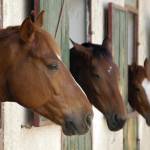Colic Incidence in Stalled Horses

Horses that spend a lot of time in their stalls tend to have a higher incidence of colic than horses that are pastured all the time. A recent study conducted at the University of Nottingham investigated why this is true.
Many factors have a bearing on the incidence of colic. These include a horse’s hydration status, exercise regimen, type and amount of feed, parasite load, and presence of tumors or enteroliths, among others. This study looked only at the influence of stalling as compared to turnout.
The study lasted four weeks and used 16 horses divided into two groups. Horses in the first group were stalled, fed hay and grain, and given light exercise. Horses in the second group were initially pastured, given no hay or grain, and not exercised. During a period of two weeks these horses were gradually switched to the management plan used on the first group.
Gut mobility was checked for each horse at the beginning and end of the study period by using ultrasonography to determine the number of gastrointestinal contractions twice a day for two days. Results showed several things:
- Intestinal movement was significantly lower in stalled than in pastured horses.
- Gut movement of pastured horses dropped when they were kept in stalls.
- The greatest changes in intestinal motion were in the region of the pelvic flexure, a common site of impaction.
The researchers believed that the continuous low-level exercise and increased intake of fluid through eating pasture forage were of more importance in preventing colic than a specific exercise routine and the feeding of grain and hay. Horses should be managed with as close to a natural pattern as possible, encouraging free exercise and minimizing hours spent in a stall.








